NEO Tools 20-130 Bedienungsanleitung
NEO Tools
Nicht kategorisiert
20-130
Lies die bedienungsanleitung für NEO Tools 20-130 (8 Seiten) kostenlos online; sie gehört zur Kategorie Nicht kategorisiert. Dieses Handbuch wurde von 7 Personen als hilfreich bewertet und erhielt im Schnitt 4.3 Sterne aus 4 Bewertungen. Hast du eine Frage zu NEO Tools 20-130 oder möchtest du andere Nutzer dieses Produkts befragen? Stelle eine Frage
Seite 1/8

REDUKTOR GAZU 20 130-
Instrukcja oryginalna (obsługi)
UWAGA: PRZED PRZYSTĄPIENIEM DO UŻYTKOWANIA NALEŻY
UWAŻNIE PRZECZYTAĆ NINIEJSZĄ INSTRUKCJĘ I ZACHOWAĆ JĄ
DO DALSZEGO WYKORZYSTANIA.
1. Zalecenia dotyczące bezpieczeństwa
W trakcie eksploatacji reduktorów należy bezwzględnie przestrzegać
ogólnie znanych przepisów BHP oraz wymagań p. poż. W szczególności:
• Zachować pełną szczelność wszystkich połączeń reduktora. Gaz palny
zmieszany z powietrzem tworzy mieszankę wybuchową.
• Bezwzględnie zabronione jest sprawdzanie szczelności połączeń
otwartym płomieniem. Szczelność można bezpiecznie sprawdzić przy
użyciu wody z mydłem.
• W przypadku mieszanin na bazie propanu należy pamiętać, że propan
jest gazem cięższym od powietrza. Nie powinien być magazynowany
w miejscach położonych poniżej terenu: piwnice, doły, rowy itp.
• Butle do gazów technicznych należy chronić przed nagrzaniem lub
oziębianiem. Zawór powinien zawsze być otwierany powoli, gdyż
gwałtowne otwarcie może spowodować uszkodzenie reduktora, a w
przypadku tlenu jego samozapłon.
• W przypadku zapłonu reduktora należy natychmiast zamknąć zawór na
butli i schłodzić reduktor wodą.
• Reduktor należy utrzymywać w czystości.
• Zabronione jest podnoszenie butli za zawór redukcyjny.
• W razie stwierdzenia jakichkolwiek nieszczelności, uszkodzeń lub
usterek w działaniu reduktora, należy zamknąć dopływ gazu, a reduktor
oddać do naprawy.
• Naprawę uszkodzonych reduktorów należy powierzyć osobom o
odpowiednich kwalifikacjach.
• Reduktora należy używać jedynie przy zachowaniu opisanych w
rozdziale 2 parametrów butli oraz temperatury.
2. Parametry
Reduktor gazu 20-130
Przeznaczenie
LPG
Ciśnienie wejściowe
4,5 – 16 bar
Ciśnienie wyjściowe
0,5 – 4
Przepustowość
8 kg / h
Temperatura pracy
-20°C do +50°C
Typ wejścia
G1, G2, G4, G5, G7, G8, G9, G10, G11, G12
Typ wyjścia
H6
3. Przeznaczenie
Zawór redukcyjny butlowy przeznaczony jest do użytku z butlami ze
skroplonym gazem petrochemicznym LPG. Umożliwia obniżenie ciśnienia
pobieranego z butli gazu do wymaganego roboczego ciśnienia
wylotowego oraz utrzymanie tego ciśnienia na możliwie stałym poziomie
niezależnie od zmian ciśnienia wlotowego. Reduktor przystosowany jest
do stosowania z butlą 11 kg.
4. Obsługa
1. Przed podłączeniem reduktora zgasić wszystkie okoliczne źródła
ognia. Zabronione jest palenie i używanie ognia podczas zakładania
reduktora i jego obsługi.
2. Przed podłączeniem reduktora upewnić się, że zawór butli gazowej 11
kg jest zamknięty, przekręcając go w lewo, następnie w prawo do
pozycji zamkniętej. Ta czynność ma również na celu przedmuchanie
zaworu, co nie dopuści do dostania się zanieczyszczeń i uszkodzenia
reduktora.
3. strożnie odkręcić zaślepkę osłaniającą Przy zamkniętym zaworze o
króciec zaworu butli. W przypadku stwierdzenia ciągłego wycieku gazu
z króćca, należy natychmiast zakręcić zaślepkę.
4. Upewnić się, że przy wylocie zaworu znajduje się gumowa uszczelka,
a jej stan nie budzi zastrzeżeń. Gwint na króćcu również powinien być
w dobrym stanie.
5. Nałożyć otwór wejściowy reduktora na króciec butli gazowej. Nakrętkę
na reduktorze dokręca się obracając ją w lewo.
6. Po nakręceniu reduktora oraz podłączeniu go do instalacji należy
sprawdzić jej szczelność. Poprzez odkręcenie zaworu butli oraz
nałożenie specjalnego testera w formie pianki, lub używając roztworu
wody z mydłem. Zabronione jest sprawdzanie szczelności przy
pomocy otwartego ognia.
7. Reduktor wyposażony jest w zawór w postaci pokrętła.
5. Postępowanie w sytuacjach awaryjnych związanych z
korzystaniem z gazu płynnego.
• W razie wyczucia zapachu gazy, nie używać otwartego ognia i
natychmiast zgasić wszystkie jego źródła.
• Otworzyć okna umożliwiając wentylację i wydostanie się gazu z
pomieszczenia.
• W przypadku awarii urządzenia gazowego i ulatniania się gazu, należy
zamknąć zawór butli i przekazać urządzenie do naprawy przez
specjalistę.
• W przypadku uszkodzenia butli należy wynieść ją poza budynek.
• Do uszkodzonego urządzenia gazowego / butli należy jak najszybciej
wezwać serwis lub osobę uprawnioną do naprawy urządzeń gazowych.
• Do odkręcania butli należy używać klucza ze stopów metali
ograniczających powstawanie iskier.
• Powiadomić osoby znajdujące się w pobliżu o zagrożeniu.
• Do pozostawionej butli należy wezwać straż pożarną, gdyż stwarza ona
zagrożenie.
EN
GAS REDUCER 20- 130
Original (manual) manual
NOTE: BEFORE OPERATION, READ THIS MANUAL CAREFULLY AND
KEEP THIS MANUAL FOR FUTURE REFERENCE.
1. Safety recommendations
During the operation of reducers, generally known health and safety
regulations and fire protection requirements must be strictly observed.
Especially:
• Maintain full tightness of all connections of the reducer. Combustible
gas mixed with air creates an explosive mixture.
• It is strictly forbidden to check the tightness of connections with an
open flame. The tightness can be checked safely with soapy water.
• -For propane based mixtures, remember that propane is a gas
heavier than air. It should not be stored in places located below the
ground: cellars, pits, ditches, etc.
• Technical gas cylinders should be protected against heating or
cooling. The valve should always be opened slowly, as sudden
opening may damage the regulator, and in the case of oxygen, its
spontaneous combustion.
• In the event of the reducer ignition, immediately close the valve on
the cylinder and cool the reducer with water.
• Keep the reducer clean.
• It is forbidden to lift the cylinder by the pressure reducing valve.
• In the event of any leaks, damage or malfunctions in the operation of
the regulator, shut off the gas supply and have the regulator repaired.
• Damaged gear units should be repaired by persons with appropriate
qualifications.
• The reducer should only be used in compliance with the cylinder
parameters and temperature described in chapter 2.
2. Parameters
Gas reducer 20-130
Destiny
LPG
Input pressure
4,5 – 16 bar
Outlet pressure
0,5 – 4
Capacity
8 kg / h
Working temperature
-20°C do +50°C
Input type
G1, G2, G4, G5, G7, G8, G9, G10, G11, G12
Output type
H6
3. Purpose
A cylinder reducing valve is designed for use with LPG liquefied petroleum
gas cylinders. It makes it possible to reduce the pressure taken from the
gas cylinder to the required working outlet pressure and to keep this
pressure as constant as possible, regardless of changes in inlet pressure.
The regulator is designed for use with an 11 kg cylinder.

4. Service
1. Before connecting the reducer, put out all nearby sources of fire. It is
forbidden to smoke and use fire when installing the gear unit and
operating it.
2. Before connecting the regulator, make sure that the valve of the 11 kg
gas cylinder is closed by turning it left and then right to the closed
position. This action is also to purge the valve, which will prevent the
ingress of debris and damage to the regulator.
3. With the valve closed, carefully unscrew the plug protecting the cylinder
valve connector. In the event of a continuous gas leakage from the stub
pipe, screw the plug on immediately.
4. Make sure that there is a rubber gasket at the valve outlet and that it is
in good condition. The thread on the nipple should also be in good
condition.
5. Put the inlet of the reducer on the gas cylinder connection. The nut on
the reducer is tightened by turning it counterclockwise.
6. After screwing on the reducer and connecting it to the installation, check
its tightness. By unscrewing the cylinder valve and applying a special
tester in the form of a foam, or by using a water and soap solution. It is
forbidden to check the tightness with an open flame.
7. The reducer is equipped with a valve in the form of a handwheel.
5. Procedure in emergency situations related to the use of liquefied
gas.
• If you smell gas, do not use an open flame and put out all sources
immediately.
• Open windows to allow ventilation and gas leakage from the room.
• In the event of a gas appliance failure and a gas leak, close the
cylinder valve and have the appliance repaired by a specialist.
• In the event of damage to the cylinder, take it outside the building.
• Call the service or a person authorized to repair gas devices as soon
as possible to the damaged gas appliance / cylinder.
• -A spark reducing alloy wrench must be used to unscrew the cylinder.
• Notify people in the vicinity of the danger.
• Call the fire brigade to the left cylinder, because it is dangerous.
DE
GASREDUZIERER 20- 130
Originales (Handbuch) Handbuch
HINWEIS: LESEN SIE DIESE ANLEITUNG VOR INBETRIEBNAHME
SORGFÄLTIG DURCH UND BEWAHREN SIE DIESE ANLEITUNG ZUM
ZUKÜNFTIGEN NACHSCHLAGEN AUF.
1. Sicherheitsempfehlungen
Beim Betrieb von Reduzierstücken sind die allgemein bekannten
Arbeitsschutzbestimmungen und Brandschutzbestimmungen unbedingt
zu beachten. Besonders:
• Halten Sie alle Anschlüsse des Untersetzungsgetriebes vollständig
dicht. Brennbares Gas vermischt mit Luft erzeugt ein explosives
Gemisch.
• Es ist strengstens verboten, die Dichtheit der Anschlüsse mit offener
Flamme zu überprüfen. Die Dichtheit kann mit Seifenlauge sicher
überprüft werden.
• Denken Sie bei Gemischen auf Propanbasis daran, dass Propan ein
Gas ist, das schwerer als Luft ist. Es sollte nicht an Orten unter der
Erde gelagert werden: Keller, Gruben, Gräben usw.
• Technische Gasflaschen sollten vor Erwärmung oder Abkühlung
geschützt werden. Das Ventil sollte immer langsam geöffnet werden,
da ein plötzliches Öffnen den Regler und bei Sauerstoff seine
Selbstentzündung beschädigen kann.
• Bei Zündung des Untersetzungsgetriebes sofort das Ventil am
Zylinder schließen und das Untersetzungsgetriebe mit Wasser
kühlen.
• Halten Sie das Reduzierstück sauber.
• Es ist verboten, den Zylinder am Druckminderventil anzuheben.
• Bei Undichtigkeiten, Beschädigungen oder Funktionsstörungen des
Reglers die Gaszufuhr absperren und den Regler reparieren lassen.
• Beschädigte Getriebe sollten von Personen mit entsprechender
Qualifikation repariert werden.
• Das Reduzierstück darf nur in Übereinstimmung mit den in Kapitel 2
beschriebenen Zylinderparametern und temperaturen verwendet -
werden.
2. Parameter
Druckminderer 20 130-
Bestimmung
LPG
Eingangsdruck
4,5 – 16 bar
Ausgangsdruck
0,5 – 4
Kapazität
8 kg / h
Arbeitstemperatur
-20°C do +50°C
Eingabetyp
G1, G2, G4, G5, G7, G8, G9, G10, G11, G12
Ausgabetyp
H6
3. Zweck
Ein Flaschenreduzierventil ist für die Verwendung mit Flüssiggasflaschen
für Flüssiggas ausgelegt. Sie ermöglicht es, den aus der Gasflasche
entnommenen Druck auf den erforderlichen Arbeitsausgangsdruck zu
reduzieren und diesen Druck unabhängig von Änderungen des
Eingangsdrucks möglichst konstant zu halten. Der Regler ist für die
Verwendung mit einer 11 kg Flasche ausgelegt.-
4. Service
1. Bevor Sie das Reduzierstück anschließen, löschen Sie alle
nahegelegenen Feuerquellen. Beim Aufstellen und Betreiben des
Getriebes ist das Rauchen und die Verwendung von Feuer verboten.
2. Stellen Sie vor dem Anschließen des Reglers sicher, dass das Ventil
der 11 kg Gasflasche geschlossen ist, indem Sie es nach links und
dann nach rechts in die geschlossene Position drehen. Diese Aktion
dient auch zum Spülen des Ventils, wodurch das Eindringen von
Schmutz und eine Beschädigung des Reglers verhindert wird.
3. Schrauben Sie bei geschlossenem Ventil vorsichtig den Stopfen ab,
der den Flaschenventilanschluss schützt. Bei anhaltendem Gasaustritt
aus der Stichleitung sofort den Stopfen aufschrauben.
4. Stellen Sie sicher, dass sich am Ventilausgang eine Gummidichtung
befindet und in gutem Zustand ist. Das Gewinde am Nippel sollte
ebenfalls in gutem Zustand sein.
5. Setzen Sie den Einlass des Reduzierstücks auf den
Gasflaschenanschluss. Die Mutter am Reduzierstück wird durch
Drehen gegen den Uhrzeigersinn festgezogen.
6. Nach dem Anschrauben des Reduzierstücks und dem Anschluss an
die Anlage die Dichtheit prüfen. Durch Abschrauben des
Flaschenventils und Auftragen eines speziellen Testers in Form eines
Schaums oder durch Verwendung einer Wasser Lösung. Die -Seifen-
Dichtheitsprüfung mit offener Flamme ist verboten.
7. Das Reduzierstück ist mit einem Ventil in Form eines Handrades
ausgestattet.
5. Verfahren in Notfallsituationen im Zusammenhang mit der
Verwendung von Flüssiggas.
• Bei Gasgeruch keine offene Flamme verwenden und alle Quellen
sofort löschen.
• Öffnen Sie die Fenster, um Belüftung und Gasaustritt aus dem Raum
zu ermöglichen.
• Bei Ausfall eines Gasgerätes und Gasleck das Flaschenventil
schließen und das Gerät von einem Fachmann reparieren lassen.
• Bringen Sie den Zylinder bei Beschädigungen außerhalb des
Gebäudes.
• Rufen Sie schnellstmöglich den Service oder eine zur Reparatur von
Gasgeräten autorisierte Person zum beschädigten Gasgerät /
Gasflasche.
• Zum Abschrauben des Zylinders muss ein Schlüssel aus einer
funkenreduzierenden Legierung verwendet werden.
• Benachrichtigen Sie Personen in der Nähe der Gefahr.
• Rufen Sie die Feuerwehr zum linken Zylinder, da es gefährlich ist.
RU
РЕДУКТОР 20- 130
Оригинальное (ручное) руководство
ПРИМЕЧАНИЕ: ПЕРЕД ЭКСПЛУАТАЦИЕЙ ВНИМАТЕЛЬНО
ПРОЧИТАЙТЕ ДАННОЕ РУКОВОДСТВО И СОХРАНИТЕ ДАННОЕ
РУКОВОДСТВО ДЛЯ БУДУЩЕГО СПРАВОЧНИКА.
1. Рекомендации по безопасности
При эксплуатации редукторов необходимо строго соблюдать
общеизвестные правила техники безопасности и охраны труда, а
также требования противопожарной защиты. Особенно:
• Следите за полной герметичностью всех соединений редуктора.
Горючий газ, смешанный с воздухом, образует взрывоопасную
смесь.
• Категорически запрещается проверять герметичность
соединений открытым пламенем. Герметичность можно
безопасно проверить с помощью мыльной воды.
• Для смесей на основе пропана помните, что пропан тяжелее
воздуха. Его нельзя хранить в местах, расположенных под
землей: подвалах, ямах, канавах и т. Д.

• Технические газовые баллоны должны быть защищены от
нагрева или охлаждения. Клапан всегда следует открывать
медленно, так как резкое открытие может повредить регулятор,
а в случае кислорода его самовозгорание.-
• В случае возгорания редуктора немедленно закройте вентиль
на цилиндре и охладите редуктор водой.
• Держите редуктор в чистоте.
• Запрещается поднимать баллон за редукционный клапан.
• В случае утечек, повреждений или сбоев в работе регулятора
отключите подачу газа и отдайте регулятор в ремонт.
• Поврежденные редукторы должны ремонтировать специалисты
с соответствующей квалификацией.
• Редуктор следует использовать только в соответствии с
параметрами и температурой цилиндра, описанными в главе 2.
2. Параметры
Редуктор 20-130
Судьба
LPG
Входное давление
4,5 – 16 bar
Выходное давление
0,5 – 4
Емкость
8 kg / h
Рабочая температура
-20°C do +50°C
Тип ввода
G1, G2, G4, G5, G7, G8, G9, G10, G11, G12
Тип выхода
H6
3. Цель
Редукционный клапан баллона предназначен для использования с
баллонами для сжиженного нефтяного газа. Это позволяет снизить
давление, забираемое из газового баллона, до необходимого
рабочего давления на выходе и поддерживать это давление как
можно более постоянным, независимо от изменений давления на
входе. Регулятор предназначен для использования с баллоном 11 кг.
4. Сервис
1. Перед подключением редуктора тушите все ближайшие источники
огня. Запрещается курить и использовать огонь при установке и
эксплуатации редуктора.
2. Перед подключением регулятора убедитесь, что клапан газового
баллона 11 кг закрыт, повернув его влево, а затем вправо в
закрытое положение. Это действие также предназначено для
продувки клапана, что предотвратит попадание мусора и
повреждение регулятора.
3. При закрытом клапане осторожно открутите заглушку,
защищающую разъем клапана баллона. В случае
продолжительной утечки газа из патрубка немедленно завинтите
пробку.
4. Убедитесь, что на выходе клапана есть резиновая прокладка и что
она в хорошем состоянии. Резьба на соске также должна быть в
хорошем состоянии.
5. Надеть вход редуктора на штуцер газового баллона. Гайка на
редукторе затягивается поворотом против часовой стрелки.
6. После прикручивания редуктора и подключения его к установке
проверьте его герметичность. Отвинтив вентиль баллона и
применив специальный тестер в виде пены, или используя водно-
мыльный раствор. Запрещается проверять герметичность
открытым пламенем.
7. Редуктор снабжен клапаном в виде маховика.
5. Порядок действий в аварийных ситуациях, связанных с
использованием сжиженного газа.
• Если вы почувствовали запах газа, не используйте открытое
пламя и немедленно потушите все источники.
• Откройте окна, чтобы обеспечить вентиляцию и утечку газа из
комнаты.
• В случае отказа газового прибора и утечки газа закройте
вентиль баллона и обратитесь к специалисту для ремонта
прибора.
• В случае повреждения баллона выньте его за пределы здания.
• Как можно скорее позвоните в сервисный центр или к лицу,
уполномоченному отремонтировать газовые приборы к
поврежденному газовому прибору / баллону.
• Для откручивания цилиндра необходимо использовать ключ из
искроустойчивого сплава.
• Сообщите об опасности людей в непосредственной близости.
• Вызовите пожарную команду к левому цилиндру, потому что это
опасно.
UA
РЕДУКТОР ГАЗУ 20- 130
Оригінальний (ручний) посібник
ПРИМІТКА: ПЕРЕД експлуатацією уважно прочитайте цей посібник
та зберігайте цей посібник для майбутньої довідки.
1. Рекомендації з техніки безпеки
Під час роботи редукторів необхідно неухильно дотримуватись
загальновідомих правил охорони праці та техніки безпеки. Особливо:
• Підтримуйте повну герметичність усіх з'єднань редуктора.
Горючий газ, змішаний з повітрям, утворює вибухонебезпечну
суміш.
• Категорично забороняється перевіряти герметичність з'єднань
відкритим вогнем. Герметичність можна безпечно перевірити
мильною водою.
• Для сумішей на основі пропану пам’ятайте, що пропан це газ, -
важчий за повітря. Його не слід зберігати в місцях, розташованих
під землею: льохах, ямах, канавах тощо.
• Технічні газові балони повинні бути захищені від нагрівання або
охолодження. Клапан завжди слід відкривати повільно, оскільки
раптове відкриття може пошкодити регулятор, а у випадку кисню
- його самозаймання.
• У разі загоряння редуктора негайно закрийте вентиль на
циліндрі та охолодіть редуктор водою.
• Тримайте редуктор в чистоті.
• Забороняється піднімати циліндр за допомогою редукційного
клапана.
• -У разі будь яких витоків, пошкоджень або збоїв у роботі
регулятора перекрийте подачу газу та відремонтуйте регулятор.
• Пошкоджені редуктори повинні ремонтувати особи з відповідною
кваліфікацією.
• Редуктор слід використовувати лише з дотриманням параметрів
та температури балона, описаних у главі 2.
2. Параметри
Редуктор 20-130
Доля
LPG
Вхідний тиск
4,5 – 16 bar
Вихідний тиск
0,5 – 4
Ємність
8 kg / h
Робоча температура
-20°C do +50°C
Тип введення
G1, G2, G4, G5, G7, G8, G9, G10, G11, G12
Тип виходу
H6
3. Purpose
A cylinder reducing valve is designed for use with LPG liquefied petroleum
gas cylinders. It makes it possible to reduce the pressure taken from the
gas cylinder to the required working outlet pressure and to keep this
pressure as constant as possible, regardless of changes in inlet pressure.
The regulator is designed for use with an 11 kg cylinder.
4. Service
1. Before connecting the reducer, put out all nearb y sources of fire. It is
forbidden to smoke and use fire when installing the gear unit and
operating it.
2. Before connecting the regulator, make sure that the valve of the 11 kg
gas cylinder is closed by turning it left and then right to the closed
position. This action is also to purge the valve, which will prevent the
ingress of debris and damage to the regulator.
3. With the valve closed, carefully unscrew the plug protecting the cylinder
valve connector. In the event of a continuous gas leakage from the stub
pipe, screw the plug on immediately.
4. Make sure that there is a rubber gasket at the valve outlet and that it is
in good condition. The thread on the nipple should also be in good
condition.
5. Put the inlet of the reducer on the gas cylinder connection. The nut on
the reducer is tightened by turning it counterclockwise.
6. After screwing on the reducer and connecting it to the installation, check
its tightness. By unscrewing the cylinder valve and applying a special
tester in the form of a foam, or by using a water and soap solution. It is
forbidden to check the tightness with an open flame.
7. The reducer is equipped with a valve in the form of a handwheel.
5. Procedure in emergency situations related to the use of liquefied
gas.
• If you smell gas, do not use an open flame and put out all sources
immediately.
• Open windows to allow ventilation and gas leakage from the room.
• In the event of a gas appliance failure and a gas leak, close the
cylinder valve and have the appliance repaired by a specialist.
Produktspezifikationen
| Marke: | NEO Tools |
| Kategorie: | Nicht kategorisiert |
| Modell: | 20-130 |
Brauchst du Hilfe?
Wenn Sie Hilfe mit NEO Tools 20-130 benötigen, stellen Sie unten eine Frage und andere Benutzer werden Ihnen antworten
Bedienungsanleitung Nicht kategorisiert NEO Tools
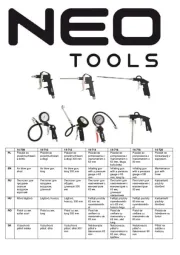
29 Mai 2025
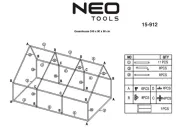
29 Mai 2025

29 Mai 2025
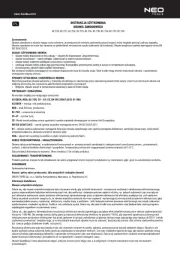
29 Mai 2025
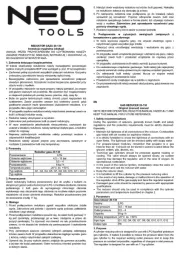
29 Mai 2025

18 August 2024

18 August 2024

19 Januar 2024
Bedienungsanleitung Nicht kategorisiert
- Ergodyne
- Chrome-Q
- Fulgor Milano
- Vankyo
- Edwards
- Bulgin
- Sitecom
- Tescoma
- FoodSaver
- Oster
- SMC
- Denon
- McKenzie
- Omega
- SanDisk
Neueste Bedienungsanleitung für -Kategorien-
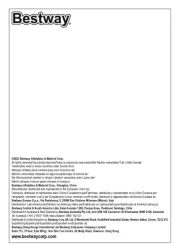
18 Juni 2025
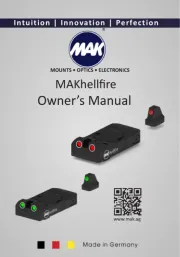
18 Juni 2025
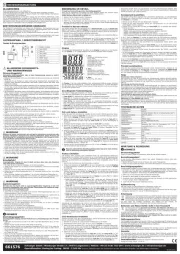
18 Juni 2025

18 Juni 2025
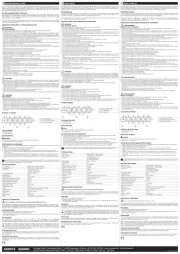
18 Juni 2025
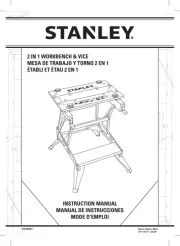
18 Juni 2025

18 Juni 2025
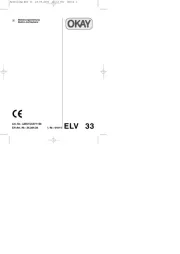
18 Juni 2025
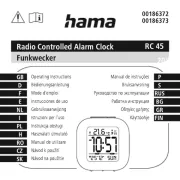
18 Juni 2025
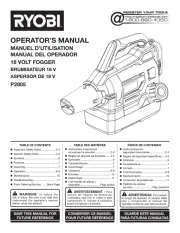
18 Juni 2025